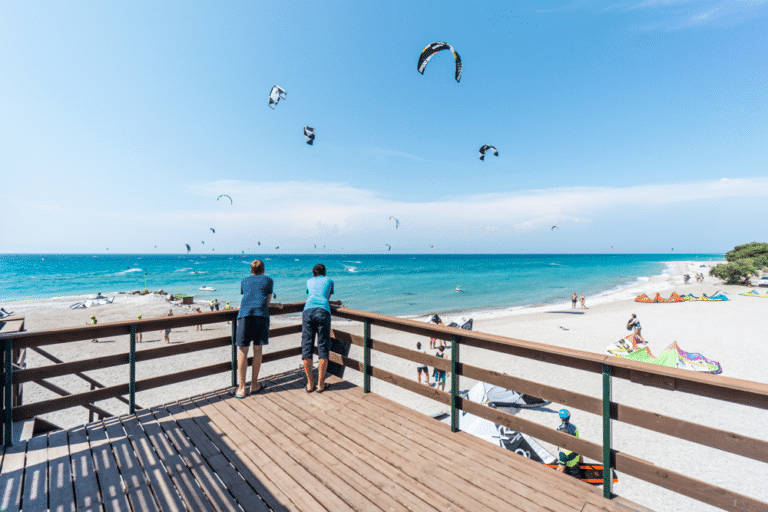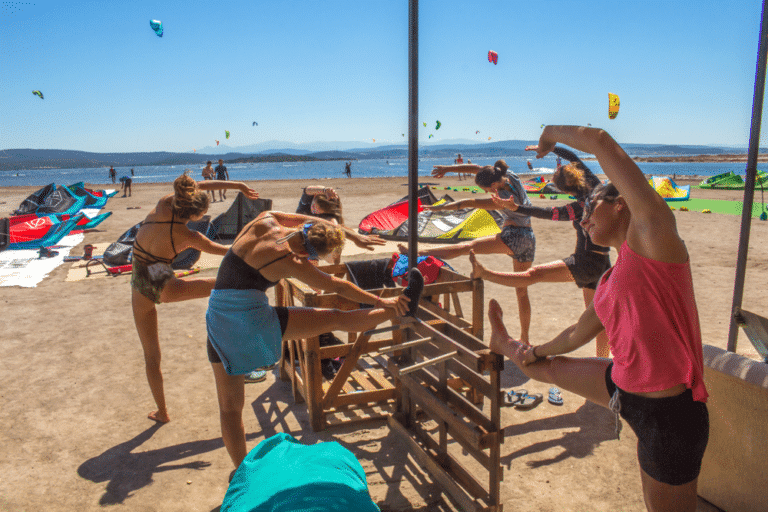Learn about kite surfing
By DBP Adventures
24 April 2023
Updated 1
In this blog post you can read about how Christoffer from DBP Adventures got started with kitesurfing, the different kitesurfing destinations we offer and some general knowledge about kitesurfing. If you have any questions about kitesurfing, or want some information worked out, you can always call or write to us!

What is kitesurfing and how did it start?
Kitesurfing is an extreme sport that combines the elements of surfing and paragliding and allows you to glide across the water using a kite (“kite”) and a board. Kitesurfing is a fantastic way to enjoy nature and at the same time challenge yourself both physically and mentally. In this blog post I (Christoffer) will give an introduction to kitesurfing and share my personal experiences and tips on how to get started with kitesurfing!
When did kitesurfing come to Europe?
Kitesurfing took off in Europe in the late 1990s and early 2000s. It was mainly surfers and windsurfers who first started experimenting with the sport, and soon it spread to most countries along the European coast.
As early as 1999, there were kite surfers on the Spanish islands and along the French coast. In France, the sport became particularly popular in Brittany, where there were good conditions for kitesurfing. By 2000, there were already kitesurfers in the Netherlands and Germany, and the sport quickly spread across Europe.
Today, kitesurfing is one of the most popular water sports in Europe and there is a large network of kitesurfers and kitesurfing schools offering lessons and courses throughout Europe. Some of the most popular places for kitesurfing in Europe are Rhodes in Greece, Tarifa in Spain, Algarve in Portugal, Lacanau in France and Sardinia in Italy.
One of the reasons why kitesurfing has become so popular in Europe is because of the large number of good kitesurfing spots along the coast of Europe and the many different types of water that the sport can be practiced in. Whether you want to explore flat water in a lagoon, surfing waves in the Atlantic or challenging yourself on a lake, there is always a kitesurfing destination in Europe that can meet your requirements.
Much effort has also been made to regulate and secure the sport in Europe and there are now many rules and regulations that must be followed when kitesurfing. This has helped make the sport safer and more accessible to everyone.
In recent years, kitesurfing has also become more popular as a competitive sport, and many kitesurfing competitions are now held in Europe and around the world. Competitions include race, freestyle and wave, and many of the best kitesurfers in the world come from Europe.
Today, kitesurfing is an important part of European surf and water sports culture, and it’s hard to imagine a time when the sport wasn’t available along Europe’s shores. With the growing popularity and spread of the sport, there is no doubt that kitesurfing will remain a staple of water sports.
Christoffers own experience
I started kitesurfing back in 2002 when it was relatively new in Denmark and Scandinavia. I started by taking lessons from an experienced instructor, learning the basic techniques and safety procedures. I took the first courses in Kongelund just outside Copenhagen.
It takes approx. 15 teaching hours, to learn kitesurfing, where you must have reasonably stable and beginner-friendly wind. Therefore, my course was taken over 3 weekends. After that I quickly invested in my own equipment and gradually learned to kitesurf on my own – I was already stuck in the first month and couldn’t get enough hours on the water.
Many of my holidays have been dedicated kitesurfing holidays where I have brought my equipment. Kitesurfing abroad is usually a completely different experience than kitesurfing in Denmark. The most obvious, of course, is that you typically kitesurf in destinations with much warmer weather, both in the water and in the air. It’s super nice to be able to get rid of the thick wetsuit (during high season in many destinations) that you often wear in Scandinavia.
Where kitesurfing abroad differs the most is the more stable and safe wind. The classic kitesurfing destinations typically have stable wind 7 out of 8 days from the same direction and with approx. same strength. It makes kitesurfing in general easier, but especially learning to kitesurf. Suddenly you can complete a kitesurfing course in 2-4 days instead of doing it over several weekends.
This is precisely one of the main reasons why we at DBP Adventures think it makes sense to learn or improve your kitesurfing skills while you’re away on holiday.
The kitesurfing destinations we offer are shown below!




Kitesurfing destinations
Kitesurfing in Rhodes
Kitesurfing in Rhodes is a fantastic experience for anyone who loves water sports. Rhodes is known for its beautiful beaches and constant wind conditions, making it an ideal destination for kitesurfing enthusiasts.
There are many kitesurfing schools and centers spread across the island where both beginners and experienced kitesurfers can learn or improve their skills. The schools usually offer courses at different levels and with different lengths, so it is easy to find one that suits your level and planned stay on the island.
Of the many places where you can kitesurf in Rhodes, Prasonisi, Theologos and Kremasti are the most popular. These beaches offer ideal wind conditions and space to exercise and have fun on the water. Prasonisi is known for its strong winds and waves, while Theologos and Kremasti have more moderate wind conditions and are more suitable for beginners. Our camp is right next to the water on Theologos beach.
The kitesurfing season in Rhodes is from April to November.
Read more about kitesurfing on Rhodes via the following link.
Kitesurfing in Turkey
In Turkey we have our kitecamp in Gülbahçe which is a great place for kitesurfing. It is beautifully located on the Aegean Sea and therefore also has good and stable wind conditions, which are ideal for kitesurfing enthusiasts.
The entire coast has crystal clear water, which is of course really delicious when you kitesurf, but also delicious when you swim or snorkel.
The kitesurfing season in Turkey extends from April to September, when the wind is strongest and most stable. All season the weather is warm and it’s nice and sunny.
You can find more information via the following link.
Kitesurfing in Montenegro
Montenegro is one of the newest places on the European kitesurfing scene. The beautiful coastline along the Adriatic Sea, crystal clear water and constant winds provide perfect conditions for kitesurfing from May to October.
Our kite camp is located in Ulcinj, which is a charming Mediterranean town with a picturesque old town and a long sandy beach.
In addition to kitesurfing, Montenegro also offers a range of other activities that can be enjoyed both before and after kitesurfing. The country has a rich culture and history, and has many historic sites and beautiful villages to explore. It is also a perfect place for those who love nature and outdoor activities, such as hiking and rock climbing.
Overall, Montenegro is one of the best kitesurfing destinations in the world, and the destination’s combination of spectacular scenery, fantastic kitesurfing conditions and a rich culture and history make it a perfect spot for any kitesurfer.
Kitesurfing in Zanzibar
Zanzibar is a popular kitesurfing destination due to its excellent kitesurfing conditions. The island is known for its warm, clear water and constant winds that allow kitesurfers to kitesurf most of the year. The island is close to the equator, which ensures constant temperatures, and the gentle winds on the eastern side of the island allow kite surfers to practice their techniques and take long “downwinder” trips along the coast.
Apart from kitesurfing, there are also plenty of other activities to explore on the island, including snorkelling, diving and exploring the local culture and history. Zanzibar is known for its beautiful beaches and crystal clear waters, so there are plenty of opportunities to relax and enjoy the tropical atmosphere.
Therefore, Zanzibar is also perfect if you are traveling in a group where some may not want to kitesurf.
In general, for all our kitesurfing destinations, we only work with professional instructors who all have international certifications and use new kitesurfing equipment, which is safe and optimal for beginners in particular.

Before you start kitesurfing
First of all, it is important to get the right equipment, including a kite/kite, a board, a ‘trapeze’ and a helmet. It is a must(!) to take lessons from an experienced instructor who can teach you the basic techniques and safety procedure.
Once you have your equipment and are ready to learn, you can start practicing on land. This allows you to learn how to control your kite and practice the basic movements before going out on the water.
When you feel ready, grab your kite and get on the water and try kitesurfing. It is important to start in calm and controlled areas with little wind, and always have an experienced kitesurfer nearby in case of problems.
Always remember to follow basic safety procedures such as having a safety line attached to your kite and always wearing a helmet and trapeze.
With patience and practice, you’ll soon be enjoying the thrill of kitesurfing and discovering new places to explore on the water.